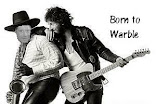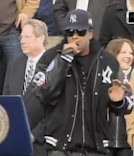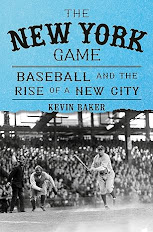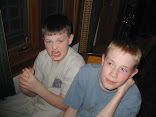I took a vacation from my computer this weekend and read a novel I highly recommend, In A Lonely Place, by Dorothy B. Hughes. (If you've seen the Humphrey Bogart movie, you still don't know the story; Hollywood changed it entirely.) And get this: it was printed on pieces of paper, not displayed on a screen! Best weekend I've had in a while. Anyway, I missed it when Beauregard Jackson Pickett Burnside submitted the following on Saturday, apparently hoping to get in on that day's John Sterling tributes. So, with apologies to Beauregard, and to John, here it is, from the Baltimore Sun of September 28, 1993.
AMONG the first to be lobbied by White House spin doctors last week after President Clinton released his health-care reform plan were radio talk show hosts. Hillary Rodham Clinton and assorted administration bigwigs briefed the radio gabmeisters and invited them to broadcast live from the White House lawn. (A few hosts saw the schmoozing for what it was and refused to attend.) It was a strong indication of how far “talk radio” has come as a force to be reckoned with.
And it’s a relatively new force, made possible by technology that allows hosts to speak live, even from points remote from their stations, with one, two or even more callers, while listeners hear all of the conversation. Two Baltimore stations (WBAL and WCBM) devote most of their schedules to talk radio, while most others gab with listeners at least part of the broadcast day.
The tradition in Baltimore goes back at least to 1948, when the first talk shows were broadcast from the Copa, a nightclub in the 100 block of West Baltimore Street. Baltimore disc jockey Jack Wells was the host. The show went out over WITH from 1 to 4 a.m. six nights a week. Seated at a table at the center of the club, Mr. Wells had a microphone in front of him and a telephone to his left.
“I’d say, ‘I’m at the Copa. Where are you? Please call me,’ ” Mr. Wells recalls.
It was, of course, one-way radio. “Listeners called me on the phone while I was in front of a live mike. I could hear the caller, but the listening audience could not. So it was up to me to make known to the listeners what the caller was saying.”
The show was famous for getting calls from the Baltimore that lived in the night: cab drivers, politicians, jockeys, number-runners, race track touts, nightclub bouncers, cops on lonely patrol and strippers from The Block.
“In most cases I would more or less repeat over the air what the caller said to me on the phone. But in some cases I couldn’t let on what was being said, some of the most shocking things. So I would often respond with something like, ‘That’s lovely. I’m so glad your aunt is getting better. Please call again and give her my best.’ “
The show was modeled after a similar one at the Copacabana in New York. “We stole the idea,” Mr. Wells says. “In those days it was thought of as a pure entertainment medium. That was all before talk radio became so angry and so politicized.”
Not much happened to talk radio in Baltimore until 1964. In that year John Sterling broadcast the first two-way conversations from WCBM. “He came along,” says John Grimes, operations manager of WBAL, “at a time when the phone company had just developed the technology of two-way radio. From there on out it was a question of any number of stations picking up the idea.”
The night of Wednesday, Feb. 26, 1969, was memorable. That evening appliance dealer Jack Luskin, listening to Gene Burns on WCBM, became so infuriated by what he believed to be biased and unfair comments about the Middle East that he rushed to the studio and barged in on the host. Mr. Luskin seized a microphone and put in his own two cents’ worth.
Glimpses couldn’t begin to list all the local hosts and their stations. Early hosts included Tony Donald (WTOW), Ron Weber (WFBR, now WJFK) and Joe Knight (WFBR). These days, too, Baltimoreans can listen to nationally known hosts such as Rush Limbaugh and Larry King. Their shows reach millions, and their books wind up on best-seller lists.
Some 25 years after the Copa closed, Mr. Wells says that when he gets a late-night call, “I’m scared to pick up the phone. I’m afraid it’s some girl from The Block calling me at the Copa to talk dirty.”
In other news, welcome to Yankee Stadium, Oakland A's!
 |
| Mad Magazine #84, January1964 |









































22 comments:
Today is exactly the type of game rhe team loses.
Today's power outage is brought to you by...the Indian Point Energy Center, which has been out of service for two years after 59 years of safe, reliable operation. Like the Yankees, the shutdown of Indian Point has made power that much harder to find, and we can look forward to a power vacuum for years to come. In Westchester and the Bronx.
JP Sears was another great tradeaway. Good thing we never need pitching, or you might think that Cashman is an idiot, getting rid of young, talented guys like Sears and King and overspending on ineffective clowns like Montas and, too often, Rodon.
But we got Soto! Whoo. Too bad nobody else can hit consistently except Volpe and Oswaldo.
Here's something new and novel. For artsy fartsy stoners:
https://www.sfgate.com/cannabis/article/sfmoma-cannabis-bongs-420-19397600.php
Maybe the bottom of the order is coming around. Trevino gets another hit. Now if only they can teach the middle of the order how to do it.
Thank god I’m not watching this game.
JM - “Lester Black is SFGATE's cannabis editor. ”
Who knew.
Hey Hoss - Did Knopf provide you with one of those for The New York Game?
If not you should negotiate for one for your next book.
Another lifeless loss that feels like it should happen more often.
Maybe it will.
I have always loved the mound visits after the pitcher has blown the lead. That's always seemed like, to me anyway, the ideal time for a mound visit. I am confused about one thing though. Why doesn't the pitching coach or manager slap the shit outta the pitcher when they get to the mound? Why?
Fucking why.
Winny - They don't because K I D S are watching.
They save that for the clubhouse.
Overuse Gonzalez, lose game, bring in Marinara after the horse has left the barn. Booneball at its finest.
The Cherry Man is pitching well.
Anyone smell a big . . . . comeback - or is that something else?
golly - that sure was a productive bottom of the 9th.
mason miller has good stuff and our top of the order made him look like Koufax
Thuuuuuuuuh Yankees lose
Pathetic.
Fucking pathetic.
See you tomorrow, gang.
Fuck tomorrow.
Ugh. To Oakland….
This team might be one Soto slump from last place.
Funny BTR - that’s exactly what I say to myself every time I drive over the bridge heading over to the east bay . . . ( the first part, anyway )
I thought the cannibis editor was Mr. Moonbeam from Central Park? Oh, different editor.
I wish I still had my grateful dead three stage bong from college (Yes, three stages - four if you count the dual chambers in the second stage. Smoothest bong hit you ever had. ....or so I heard). Not that I'd use it anymore. But it would probably fetch a 6 or 7 figure price on the collectibles market.
BTW, Dorothy B. Hughes is a GREAT noir writer, not just with In A Lonely Place.
Post a Comment